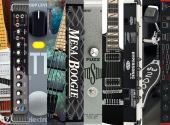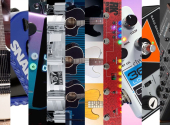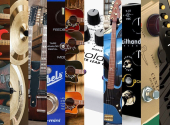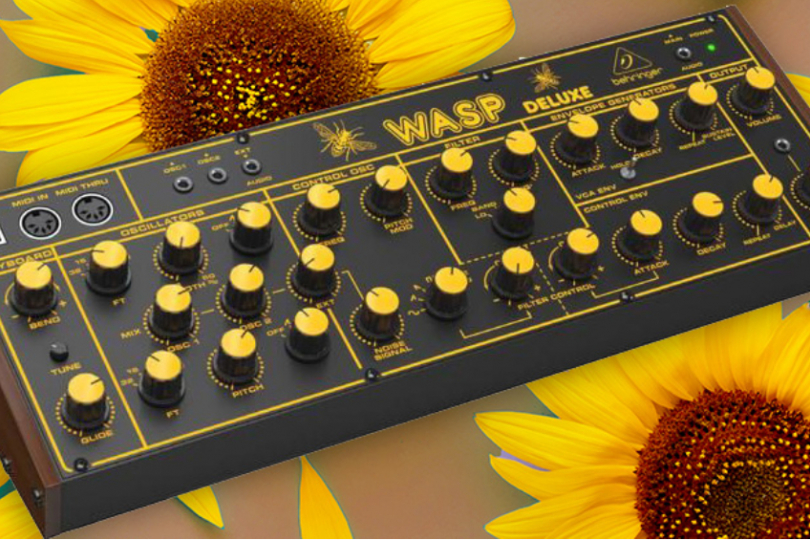
Buzz... Buzz... Buzz: Behringer Wasp Deluxe
Behringer has recently released a swarm of clones, from the Model D, Pro 1, Cat and more. Some consumers may say that the synth market buzzing is deafening. Some smaller boutique companies might have felt a little sting from this giant German company. Sure, arguments about Behringer’s ethics abound in synth forums and YouTube channels, but the actual hardware appeal, ethics aside, is twofold: price and sound. The Behringer Wasp Deluxe is another box that has its roots in '70s and '80s synthesizer lore. Could it possibly be an evolution of the original or just a black and yellow smear on the windshield of electronic music?
In 1978 a small company named Electronic Dream Plant wanted to come up with a synth for the everyman. It wasn’t necessarily convenient to lug around a huge Moog modular system, never mind the price of the monster. Created by Adrian Wagner and Chris Huggett (EDP), the first Wasp was a plastic affair with a 2-octave touch keyboard, built-in speakers and battery-powered. Although the hardware was quite toy-like, the sound was anything but. This little synth caught the ear of musicians like Dave Greenfield of The Stranglers, Nick Rhodes of Duran Duran, 808 State and more, who all used it on various albums. The Wasp was one of the earliest digital/analogue hybrid monosynths. The moment I saw the Behringer Wasp Deluxe remake, I was interested. I was in the market for a simple budget monosynth and I wanted something… different. I heard the buzz. I feared the stinger. I captured this little bugger in a jar and have been torturing it for weeks now.
Can something sound black and yellow?
Strangely, yes. It’s weird, but if I look at a synth, my imagination actually comes close to what it really sounds like. With the Wasp, my prediction was quite spot-on. The hardware itself is a simple affair: a metal box with wooden cheeks, twenty-eight knobs and a few patch points. It’s got the usual midi connections and such on the back. Nothing new or special to report here—it is a solid piece of kit with no bells or whistles. I must mention though, that the knobs on this box feel better than on any other synth in my collection. Give them a twist and the result is a smooth and solid action, a good feeling all around. My experience with Behringer products had been positive, but the quality of the Wasp seems to be a step up—a solidly built nest of buzzing transistors and other bits and bobs.
Let’s take a closer look at the layout. Starting from left to right, we begin with the bend, glide and tune pots. Personally, the only useful utility here is the glide knob. The tune pot is set and forget about the bend knob, although true to the original, it's uncomfortable to use compared to a pitch-bend wheel seen on most other synths.
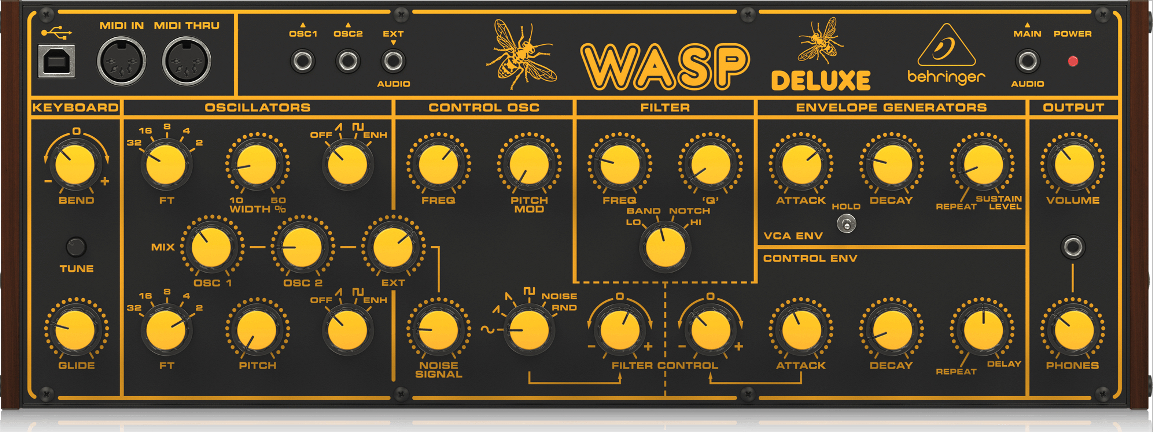
The oscillator section has us choosing the “octave” using the old pipe organ standard of feet. Oscillator one has a pulse-width modulation knob which takes us through a smaller range than usual, while oscillator two has a dedicated pitch knob that doesn’t quite reach an octave either way. Odd, but it is enough to be able to detune the oscillators from each other for thicker sounds. Both oscillators offer saw, square and enhanced waveforms, the enhanced choice being a set pulse-width modulation. I use the ENH setting on both oscillators personally. I feel that they boost the buzz and add a bit of sweet aggression. The saw and square waves are bog-standard, if not a bit dirtier than usual. Now, the oscillators are “digitally controlled,” but it seems like Behringer also reproduced the 1978 digital standard here. The sound doesn’t strike me as ones and zeros compared to other digitally-touched machines. We also have an external input knob and a noise oscillator. I feel the noise is pinker than white. It does its job.
Next, we have the control oscillator section. This was EDP’s convoluted name for LFO. This section is fairly run of the mill. However, mixed with some spice from the envelope section you can get some crazy stuff—like a wasp’s flight on a windy day. It seems all over the place and can be fun to let it go wild. Anyway, you have got frequency and pitch modulation, along with six different waveforms to utilise. The frequency does journey into audio range, so this opens the synth up a bit into ring-modulation type territory. The filter control knobs take our modulations from negative to positive values for added bonus.
Other than the oscillators, the analogue multimode filter is a high point. There are four modes (low, high, notch and band) and they all do a spectacular job of filtering unwanted stray swarms. With the glorious resonance, filter sweeps can scream and growl with the best of them. I particularly enjoy employing the notch filter for a variety of sound approaches. Smooth.
Finally, the envelope section has dedicated knobs for both filter and VCA. Now, there are only 3 knobs for each compared to the regular four: attack, decay and sustain. However, there is an added bonus of a repeat switch for each. Like I mentioned earlier, when mixed with the LFO section these repeat switches can get you lost in a maze of weird, glitchy rhythms… like being shaken around in a wasp’s nest.
A place in the ecosystem… even for pests.
It’s hard to describe a sound. I can wax poetic about analogue oscillators, filters, envelopes and the like, but that does not do much other than state the obvious and glue expectations. You can look at a simple monosynth and, if you are familiar with the basic structure, know what to expect: no surprises, just a hum-drum approach to stereotypical subtractive synthesis. The path of oscillator to filter to envelope is a well-travelled one. Instead of explaining why the Wasp Deluxe might be for you, let me explain how it fits into my synth setup.
First of all, as the oscillators go down to 32 feet, I use the Wasp Deluxe for bass. There is a subtle buzz even at the bottom end of the filter that adds a bit of spice to what would normally be a bland and common sound. I keep it on the ENH oscillator setting for a bit of drift that helps to fill out a mix. When I start twisting the filter knob, the buzz becomes more and more prevalent. I have recently started using the Wasp Deluxe as a foundation for a new musical experiment that strikes me as Sabbath with synths. A friend of mine labelled it as synth-doom. This is where it fits in for me: thick, buzzy, stoner and heavy. Now, I am sure you could do some synth-pop with it, sticking with higher octave filtered saw waves, but turn those octaves down, modulate everything and you are talking stoner-metal sludgy frequencies that could shake the fur off a mammoth.
The Behringer Wasp Deluxe might be simplistic and not for everyone, but damn does this pest have a place in my meadow. Its buzzing is a meditative drone that makes you feel like you are being crushed by tons of oak sap and the sting of this thing is more like a throbbing plunger. All in all, a nice addition, a seemingly niche machine and a worthwhile and valuable species.
If you have found an error or typo in the article, please let us know by e-mail info@insounder.org.


